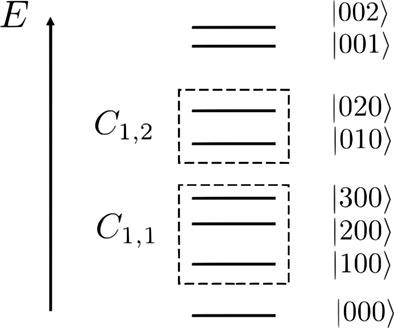当前位置:
X-MOL 学术
›
J. Comput. Chem.
›
论文详情
Our official English website, www.x-mol.net, welcomes your feedback! (Note: you will need to create a separate account there.)
Advances in vibrational configuration interaction theory - part 2: Fast screening of the correlation space
Journal of Computational Chemistry ( IF 3 ) Pub Date : 2021-10-15 , DOI: 10.1002/jcc.26764 Tina Mathea 1 , Taras Petrenko 1 , Guntram Rauhut 1
Journal of Computational Chemistry ( IF 3 ) Pub Date : 2021-10-15 , DOI: 10.1002/jcc.26764 Tina Mathea 1 , Taras Petrenko 1 , Guntram Rauhut 1
Affiliation

|
For larger molecules, the computational demands of configuration selective vibrational configuration interaction theory (cs-VCI) are usually dominated by the configuration selection process, which commonly is based on second order vibrational Møller-Plesset perturbation (VMP2) theory. Here we present two techniques, which lead to substantial accelerations of such calculations while retaining the desired high accuracy of the final results. The first one introduces the concept of configuration classes, which allows for a highly efficient exploitation of the analogs of the Slater-Condon rules in vibrational structure calculations with large correlation spaces. The second approach uses a VMP2 like vector for augmenting the targeted vibrational wavefunction within the selection of configurations and thus avoids any intermediate diagonalization steps. The underlying theory is outlined and benchmark calculations are provided for highly correlated vibrational states of several molecules.
中文翻译:

振动构型相互作用理论的进展 - 第 2 部分:相关空间的快速筛选
对于较大的分子,构型选择性振动构型相互作用理论 (cs-VCI) 的计算需求通常由构型选择过程主导,该过程通常基于二阶振动 Møller-Plesset 扰动 (VMP2) 理论。在这里,我们介绍了两种技术,它们可以显着加速此类计算,同时保持所需的最终结果的高精度。第一个引入了配置类的概念,它允许在具有大相关空间的振动结构计算中高效利用 Slater-Condon 规则的类似物。第二种方法使用类似 VMP2 的向量来增强配置选择内的目标振动波函数,从而避免任何中间对角化步骤。
更新日期:2021-11-16
中文翻译:

振动构型相互作用理论的进展 - 第 2 部分:相关空间的快速筛选
对于较大的分子,构型选择性振动构型相互作用理论 (cs-VCI) 的计算需求通常由构型选择过程主导,该过程通常基于二阶振动 Møller-Plesset 扰动 (VMP2) 理论。在这里,我们介绍了两种技术,它们可以显着加速此类计算,同时保持所需的最终结果的高精度。第一个引入了配置类的概念,它允许在具有大相关空间的振动结构计算中高效利用 Slater-Condon 规则的类似物。第二种方法使用类似 VMP2 的向量来增强配置选择内的目标振动波函数,从而避免任何中间对角化步骤。


























 京公网安备 11010802027423号
京公网安备 11010802027423号